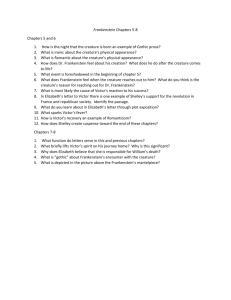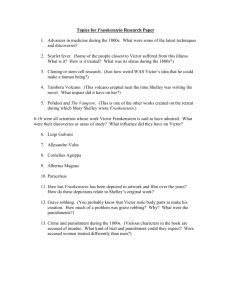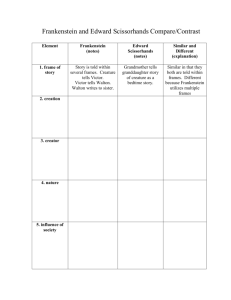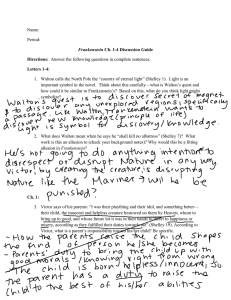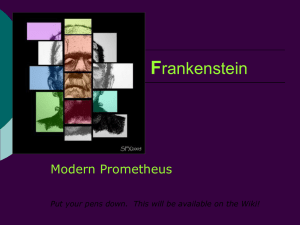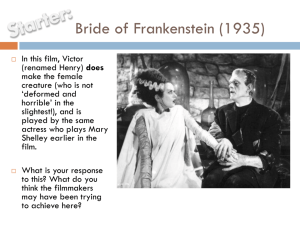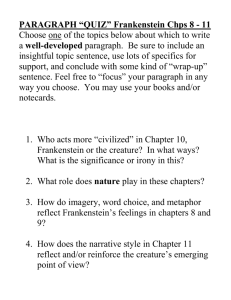Memory in English
advertisement
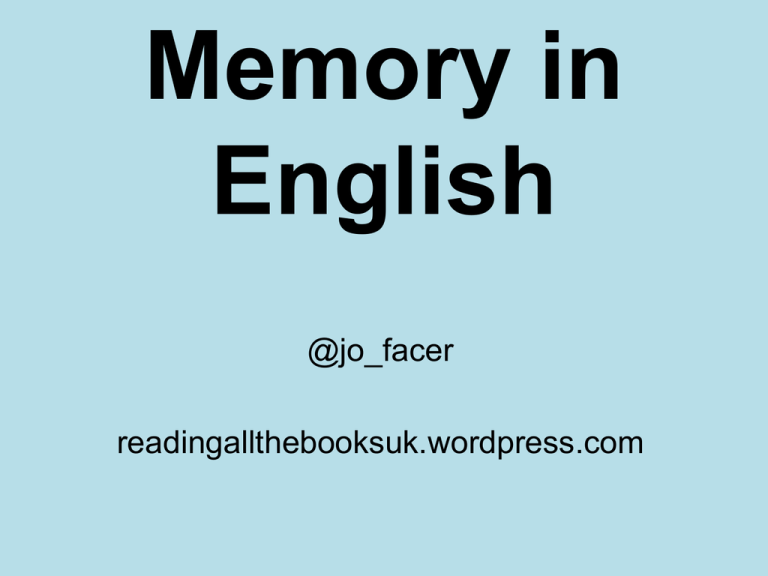
Memory in English @jo_facer readingallthebooksuk.wordpress.com • Why is memory important in English? • What is memory, and how does it work? • How can we build memory in English in a classroom? • How can we build memory in English as a whole school? Why is memory important in English? ‘…networks of perceptions…’ Jones sacrificed and knocked in a run Jones sacrificed and knocked in a run ‘General knowledge is like oxygen. It is vitally important, but we only notice it when it is not there.’ ‘Less privileged children are denied consistent interchanges with literate persons and fail to receive this information in school.’ ‘When it comes to knowledge, those who have more gain more.’ ‘But whosoever hath not, from him shall be taken away even that he hath.’ Analysis ‘We achieve skilled performance through committing knowledge to long-term memory and practising using it.’ othmarstrombone.wordpress.com ‘The Knowledge’ ‘The Skills’ What is memory, and how does it work? pragmaticreform.wordpress.com ‘Memory is the residue of thought.’ ‘Learning is deeper and more durable when it’s effortful.’ ‘desirable difficulties’ How can we build memory in English in a classroom? ‘new information combined with minimal guidance does not lead to effective learning. Instead, it leads to confusion, frustration and misconceptions.’ ‘Why does it matter if a child knows the date of the Battle of Hastings?’ ‘It matters because facts stored in long-term memory are not islands unto themselves; they join up with other facts to form associative networks of understanding.’ A. Mary Shelley’s Frankenstein: Context D. Plot 1665 John Milton writes ‘Paradise Lost’ 1. Letters 1-4 Captain Robert Walton sailing to the North Pole, writes letters to his sister telling of his dangerous mission and finding Frankenstein. 1793 The Enlightenment creates the French terror and guillotine 1797 Coleridge writes The Rime of the Ancient Mariner The Frankensteins adopt Elizabeth; Henry Clerval is a family friend; Victor studies at Ingolstadt. 1797 Mary Wollstonecraft dies after giving birth to her daughter Mary 2. Chapters 1-3 1816 Shelley’s wife Harriet commits suicide after Percy eloped with Mary Victor studies and animates matter; he brings a creature to life; Elizabeth entreats Victor to return. 1816 Byron writes his poem, ‘Prometheus’ 3. Chapters 4-6 1815 Three of Mary’s four children die in childbirth Victor’s father writes that Victor’s brother William has been murdered; Justine is hanged for murder; Victor goes to the Alps. 1816 Mary writes a diary entry about her dream on the death of her child 4. Chapters 7-9 1816 Byron, Percy and Mary Shelley tell ghost stories in Geneva Victor meets the creature in the Alps; the creature tells his story, and how he came to learn language. 1818 Mary Shelley publishes her novel Frankenstein 5. Chapters 10-12 6. Chapters 13-15 The creature tells of learning reading, history and literature; he meets the old man in the cottage, but the others beat him away. 7. Chapters 16-18 The creature tells of murdering Victor’s brother, and framing Justine; he demands Victor create him a female; Victor concedes. 8. Chapters 19-22 Victor in Scotland creates another creature; in terror he destroys it; the creature threatens his wedding night; he finds Clerval dead. 9. Chapters 22-24 Victor marries Elizabeth; the creature finds and kills her; Victor pursues the creature to the North Pole. 10. Letters 5-9 Walton writes of Frankenstein’s death, his encounter with the creature, who tells of his immense suffering, then leaves to die. B. Characters 1. Robert Walton Explorer seeking the North Pole 2. Victor Frankenstein Scientist who creates a living creature 3. The Creature Ostracised as monstrous, he murders Victor’s family 4. Elizabeth Lavenza marries Frankenstein, is killed on her wedding night 5. Justine Moritz convicted of murder of Victor’s brother 6. Henry Clerval Family friend killed by the creature C. Themes 1. Hubris and Nemesis recreating life has terrible consequences 2. Romantic and Gothic terror and imagination, natural and unnatural 3. Prejudice and Revenge alienation and murder 4. Innocence and Loss Justine, William, Henry, Elizabeth and Alfonse die 5. Science and Creation nurture and nature 6. Death and Birth Victor’s mother’s death leads to a creature’s birth 7. Society and Isolation Enlightenment reason and exclusion E. Literary Devices 1. Perspective shifting viewpoint 2. Allusions references to other literature 3. Prolepsis foreboding, foreshadowing, prefiguring 4. Epithets characteristic words used for a character 5. Symbolism light, fire, ice Why use knowledge maps? 1. Decisions 2. Clarity 3. Revision ‘One of the best habits a learner can instil in herself is regular self-quizzing.’ Quizzing 1. Purposeful 2. Targeted 3. Instantly corrected Why use multiple choice questions? 1. Workload 2. Diagnosis 3. Breadth How to design multiple choice questions: 1. Five options 2. Plausible distractors 3. Unambiguously wrong distractors 4. Misconceptions as distractors 5. Multiple correct options When did Mary Shelley publish her novel, ‘Frankenstein’? A) 1665 B) 1793 C) 1797 D) 1815 E) 1818 What happened in 1797? A) John Milton wrote ‘Paradise Lost.’ B) The Enlightenment created the French terror and the guillotine. C) Coleridge wrote ‘The Rime of the Ancient Mariner.’ D) Three of Mary’s four children died in childbirth. E) Mary Shelley published her novel ‘Frankenstein.’ A. Mary Shelley’s Frankenstein: Context D. Plot 1665 John Milton writes ‘Paradise Lost’ 1. Letters 1-4 Captain Robert Walton sailing to the North Pole, writes letters to his sister telling of his dangerous mission and finding Frankenstein. 1793 The Enlightenment creates the French terror and guillotine 1797 Coleridge writes The Rime of the Ancient Mariner The Frankensteins adopt Elizabeth; Henry Clerval is a family friend; Victor studies at Ingolstadt. 1797 Mary Wollstonecraft dies after giving birth to her daughter Mary 2. Chapters 1-3 1816 Shelley’s wife Harriet commits suicide after Percy eloped with Mary Victor studies and animates matter; he brings a creature to life; Elizabeth entreats Victor to return. 1816 Byron writes his poem, ‘Prometheus’ 3. Chapters 4-6 1815 Three of Mary’s four children die in childbirth Victor’s father writes that Victor’s brother William has been murdered; Justine is hanged for murder; Victor goes to the Alps. 1816 Mary writes a diary entry about her dream on the death of her child 4. Chapters 7-9 1816 Byron, Percy and Mary Shelley tell ghost stories in Geneva Victor meets the creature in the Alps; the creature tells his story, and how he came to learn language. 1818 Mary Shelley publishes her novel Frankenstein 5. Chapters 10-12 6. Chapters 13-15 The creature tells of learning reading, history and literature; he meets the old man in the cottage, but the others beat him away. 7. Chapters 16-18 The creature tells of murdering Victor’s brother, and framing Justine; he demands Victor create him a female; Victor concedes. 8. Chapters 19-22 Victor in Scotland creates another creature; in terror he destroys it; the creature threatens his wedding night; he finds Clerval dead. 9. Chapters 22-24 Victor marries Elizabeth; the creature finds and kills her; Victor pursues the creature to the North Pole. 10. Letters 5-9 Walton writes of Frankenstein’s death, his encounter with the creature, who tells of his immense suffering, then leaves to die. B. Characters 1. Robert Walton Explorer seeking the North Pole 2. Victor Frankenstein Scientist who creates a living creature 3. The Creature Ostracised as monstrous, he murders Victor’s family 4. Elizabeth Lavenza marries Frankenstein, is killed on her wedding night 5. Justine Moritz convicted of murder of Victor’s brother 6. Henry Clerval Family friend killed by the creature C. Themes 1. Hubris and Nemesis recreating life has terrible consequences 2. Romantic and Gothic terror and imagination, natural and unnatural 3. Prejudice and Revenge alienation and murder 4. Innocence and Loss Justine, William, Henry, Elizabeth and Alfonse die 5. Science and Creation nurture and nature 6. Death and Birth Victor’s mother’s death leads to a creature’s birth 7. Society and Isolation Enlightenment reason and exclusion E. Literary Devices 1. Perspective shifting viewpoint 2. Allusions references to other literature 3. Prolepsis foreboding, foreshadowing, prefiguring 4. Epithets characteristic words used for a character 5. Symbolism light, fire, ice ‘My Fate is nearly fulfilled.’ What theme does Shelley allude to here, and what language technique does she use? A) Mary Shelley alludes to the theme of fate, and uses epiplexis. B) Mary Shelley alludes to the theme of transience, and uses Gothicism. C) Mary Shelley alludes to the theme of despair, and uses allusion. D) Mary Shelley alludes to the theme of destiny, and uses alliteration. E) Mary Shelley alludes to the theme of the inescapable, epithets. ‘The world was to me a secret which I desired to divine.’ What does this quotation reveal about Frankenstein’s character? A) This quotation reveals that Frankenstein is curious and obsessed with discovery even beyond human limits. B) This quotation reveals that Frankenstein is interested in science above all else. C) This quotation reveals that Frankenstein wishes to be as powerful as the divine God. D) This quotation reveals that Frankenstein seeks revenge on his university professors. E) This quotation reveals that Frankenstein is isolated from human society. How can we build memory in English in a classroom? Hidden bodies of knowledge Sequence A. Mary Shelley’s Frankenstein: Context D. Plot 1665 John Milton writes ‘Paradise Lost’ 1. Letters 1-4 Captain Robert Walton sailing to the North Pole, writes letters to his sister telling of his dangerous mission and finding Frankenstein. 1793 The Enlightenment creates the French terror and guillotine 1797 Coleridge writes The Rime of the Ancient Mariner The Frankensteins adopt Elizabeth; Henry Clerval is a family friend; Victor studies at Ingolstadt. 1797 Mary Wollstonecraft dies after giving birth to her daughter Mary 2. Chapters 1-3 1816 Shelley’s wife Harriet commits suicide after Percy eloped with Mary Victor studies and animates matter; he brings a creature to life; Elizabeth entreats Victor to return. 1816 Byron writes his poem, ‘Prometheus’ 3. Chapters 4-6 1815 Three of Mary’s four children die in childbirth Victor’s father writes that Victor’s brother William has been murdered; Justine is hanged for murder; Victor goes to the Alps. 1816 Mary writes a diary entry about her dream on the death of her child 4. Chapters 7-9 1816 Byron, Percy and Mary Shelley tell ghost stories in Geneva Victor meets the creature in the Alps; the creature tells his story, and how he came to learn language. 1818 Mary Shelley publishes her novel Frankenstein 5. Chapters 10-12 6. Chapters 13-15 The creature tells of learning reading, history and literature; he meets the old man in the cottage, but the others beat him away. 7. Chapters 16-18 The creature tells of murdering Victor’s brother, and framing Justine; he demands Victor create him a female; Victor concedes. 8. Chapters 19-22 Victor in Scotland creates another creature; in terror he destroys it; the creature threatens his wedding night; he finds Clerval dead. 9. Chapters 22-24 Victor marries Elizabeth; the creature finds and kills her; Victor pursues the creature to the North Pole. 10. Letters 5-9 Walton writes of Frankenstein’s death, his encounter with the creature, who tells of his immense suffering, then leaves to die. B. Characters 1. Robert Walton Explorer seeking the North Pole 2. Victor Frankenstein Scientist who creates a living creature 3. The Creature Ostracised as monstrous, he murders Victor’s family 4. Elizabeth Lavenza marries Frankenstein, is killed on her wedding night 5. Justine Moritz convicted of murder of Victor’s brother 6. Henry Clerval Family friend killed by the creature C. Themes 1. Hubris and Nemesis recreating life has terrible consequences 2. Romantic and Gothic terror and imagination, natural and unnatural 3. Prejudice and Revenge alienation and murder 4. Innocence and Loss Justine, William, Henry, Elizabeth and Alfonse die 5. Science and Creation nurture and nature 6. Death and Birth Victor’s mother’s death leads to a creature’s birth 7. Society and Isolation Enlightenment reason and exclusion E. Literary Devices 1. Perspective shifting viewpoint 2. Allusions references to other literature 3. Prolepsis foreboding, foreshadowing, prefiguring 4. Epithets characteristic words used for a character 5. Symbolism light, fire, ice ‘People can keep only so much information in mind at once.’ ‘Familiarity illusion’ ‘Varied practice’ ‘Interleaving’ @LizzieStrang • Do all teachers have a firm understanding on key concepts/knowledge to be mastered in the SOW? • Could you make more use of systematic low stakes quizzes across the unit? • Do you revisit this unit at different points in the year? • Could you interleave this unit with any other topics taught? • Why is memory important in English? • What is memory, and how does it work? • How can we build memory in English in a classroom? • How can we build memory in English as a whole school? 1. What is knowledge comparable to and why? a) We can compare knowledge to facts, because it means knowing only the facts and not their meaning. b) We can compare knowledge to riding a bike, because you never forget it. c) We can compare knowledge to oxygen, because it is vital but we only notice it when it is not there. d) We can compare knowledge to a kite, because knowledge alone allows you to soar. e) We can compare knowledge to a fingerprint, because each piece of knowledge is unique. 2. How many items can we hold in our working memory? a) We can hold 1-2 items in our working memory. b) We can hold 3-4 items in our working memory. c) We can hold 5-6 items in our working memory. d) We can hold 7-8 items in our working memory. e) We can hold limitless items in our working memory. 3. What is the greatest benefit of teaching students isolated facts? a) Teaching students isolated facts ensures students only have to learn a small number of ideas. b) Teaching students isolated facts means students will focus on only those facts and will not be distracted by any other concepts or ideas. c) Teaching students isolated facts means that they will be better prepared for the C21 society. d) Teaching students isolated facts enables them to link knowledge together in a network of understanding. e) Teaching students isolated facts means teachers don’t have to teach anything more complicated. 4. What is the most effective way to carry out retrieval practice? a) It is most effective to space retrieval practice, to not allow time for students to forget between tests. b) It is most effective to space retrieval practice, to allow time for students to begin to forget between tests. c) It is most effective to carry out retrieval practice infrequently, as students don’t need to revisit key ideas as often as we think. d) It is most effective to carry out retrieval practice immediately after teaching students knowledge. e) It is most effective to drill retrieval practice, to ensure students are constantly being tested. 5. What is the best idea to use to organize your curriculum? a) Cultural capital b) Interleaving c) Memory d) Cross-curricular links e) Something else
